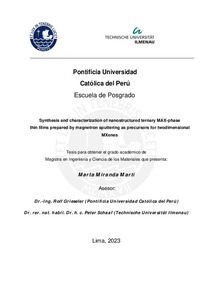Synthesis and characterization of nanostructured ternary MAX-phase thin films prepared by magnetron sputtering as precursors for twodimensional MXenes
Abstract
MAX phase thin films can be fabricated through firstly depositing a precursor thin
film consisting of the initial elements M, A, and X close to the MAX phase stoichiometry
employing physical vapor deposition techniques with a subsequent thermal annealing
process.
This work presents different deposition configurations (multilayer and co-sputtering)
for the fabrication of the Ti2AlC and Ti3AlC2 MAX phase thin films by magnetron
sputtering from three elemental targets (Ti, Al, and C). It was found that the depositions
followed mainly amorphous thus the MAX phase was not able to form. By implementing
the deposition parameters such as temperature and substrate voltage, the deposition
morphology could be tailored to crystalline and MAX phases could be created.
Moreover, Ti2AlC and Ti3AlC2 nanostructured MAX phase thin films were fabricated
by magnetron sputtering with three elemental targets (Ti, Al, and C) at oblique angle,
resulting in a columnar thin film, and the properties of the thin film were described as
a function of the column tilt angle.
Lastly, the MAX phases at normal configuration and at oblique angle configuration
were wet etched and the properties of the resulting MXene thin films were analyzed.
It was demonstrated that only the surface of the sample was attacked by the etching
solution. Thus, only the surface of the MAX phase was transformed into MXene.
This hypothesis was verified by multiple characterizations such as e.g., X-Ray Diffraction
and Raman spectroscopy to understand the possible morphology and chemical
transformation and its influence on the etched thin film properties.
The aim of this work is to unravel the connection between the morphology of the
MAX phase thin films and the properties of the resulting MXenes. By understanding
this relationship, it would be possible to tailor their features for specific applications. MAX-Phasen- Dünnschichten können hergestellt werden, indem zunächst eine Vorläufer-
Dünnschicht mit den drei Elementen M, A und X nahe der Stöchiometrie der MAXPhasen
durch physikalische Abscheidung aus der Gasphase abgeschieden wird, gefolgt
von einem thermischen Glühprozess.
In dieser Arbeit werden verschiedene Abscheidungskonfigurationen (Multilayer und
Co-Sputtern) für die Herstellung von Ti2AlC und Ti3AlC2-MAX-Phasen-Dünnschichten
durch Magnetron-Sputtern aus drei elementaren Targets (Ti, Al und C) vorgestellt. Es
wurde festgestellt, dass die Abscheidungen hauptsächlich amorph erfolgten, so dass sich
die MAX-Phase nicht bilden konnte. Durch Einstellen der Abscheidungsparameter wie
Temperatur und Substratspannung konnte die Abscheidungsmorphologie auf kristalline
beeinflusst werden.
Darüber hinaus wurden Ti2AlC and Ti3AlC2 nanostrukturierte MAX-Phasen -
Dünnschichten durch Magnetronsputtern mit drei elementaren Targets (Ti, Al und
C) in einem schrägen Winkel hergestellt (Oblique Angle Deposition), was zu einer
säulenförmigen Dünnschicht führte, und die Eigenschaften der Dünnschicht wurden als
Funktion des Säulenwinkels beschrieben.
Schließlich wurden die MAX-Phasen in normaler und OAD-Konfiguration geätzt und
die Eigenschaften der resultierenden MXen-Dünnschichten analysiert. Es zeigte sich,
dass nur die Oberfläche der Probe von der Ätzlösung angegriffen wurde. Somit wurde
nur die Oberfläche der MAX-Phase in MXen umgewandelt. Diese Hypothese wurde
durch verschiedene Untersuchungen wie Röntgenbeugung und Raman-Spektroskopie
verifiziert, um die mögliche Morphologie und chemische Umwandlung und deren Einfluss
auf die Eigenschaften der geätzten Dünnschicht zu verstehen.
Ziel dieser Arbeit ist, den Zusammenhang zwischen der Morphologie der MAX-Phasen-
Dünnschichten und den Eigenschaften der entstehenden MXene zu entschlüsseln. Durch
das Verständnis dieses Zusammenhangs wäre es möglich, die Eigenschaften dieser
Schichten für bestimmte Anwendungen zu optimieren.
Temas
Películas delgadas
Espectrometría
Nanopartículas
Espectrometría
Nanopartículas
Para optar el título de
Maestro en Ingeniería y Ciencia de los Materiales
Collections
The following license files are associated with this item:






